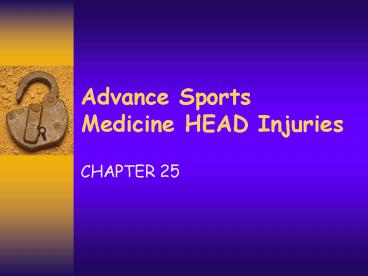Advance Sports Medicine HEAD Injuries - PowerPoint PPT Presentation
1 / 12
Title:
Advance Sports Medicine HEAD Injuries
Description:
Protective coverings that inclose the spinal cord and the brain. ... V Trigeminal=chewing, face & mouth touch/pain. VI Abducens= abducts the eye ... – PowerPoint PPT presentation
Number of Views:233
Avg rating:3.0/5.0
Title: Advance Sports Medicine HEAD Injuries
1
Advance Sports Medicine HEAD Injuries
- CHAPTER 25
2
Vocabulary
- Cerebral hyperemia
- Cerebral edema
- Occlusion
- Malocclusion
- Epistaxis
- Cauterization
- hyphemia
- Hematoma auris
- Nystagmus
- Keloid
- Photophobia
- External Otitis
- Orbital Hematoma
- Encephalon
- Meninges
- Cerebrospinal fluid
- Automatism
- Posttraumatic amnesia
- Retrograde amnesia
- Intracranial hemorrhage
- Tinnitus
- Rhombergs sign
3
ANATOMY--
- HEAD-bones of skull
- scalp is the first line of defense
- Bones of the skull makes up the second line of
defense for the brain - 28 bones in the skull
- Frontal, temporal, parietal, occipital
- MENINGES- skull matter
- Protective coverings that inclose the spinal cord
and the brain. Their primary functions are to
channel forces away from the vital structures and
provide a passage way for blood vessels,
lymphatic vessels and nerves
4
The meninges
- Dura mater
- Superficial lines against the skull. It is the
toughest and contains blood vessels and nerves - Arachnoid mater
- Netlike structure, forming a web over the brain
- Pia mater
- Deepest and follows all the irregular contours of
the brain
5
MECHANISM OF INJURY
- Direct blow-
- thin bone produces local trauma in
bending/tensile stress inner table - Thick bone non trauma local in bending/tensile
stress with peripheral out bending/tensile stress
with peripheral out bending outer table - Size of impact smaller more serious than large
surface area - Coup injury- a forceful blow to the resting
moveable head usually produces maximal brain
injury beneath the point of cranial impact - Contra coup injury- when a moving head collides
with a nonmoving object producing maximal brain
injury to the opposite site of cranial impact
6
Cranial Nerves
- I Olfactory
- II Optic
- III Oculomotor
- IV Trochlear
- V Trigeminal
- VI Abducens
- VII Facial
- VIII Vestibulocochlear
- IX Glossopharyngeal
- X Vagus
- XI Accessory
- XII Hypoglossal
7
Cranial Nerves
- VII Facial facial expressions, secretion of
tears saliva, taste - VIII Vestibulocochlear (auditory) hearing
equillibrium - IX Glossopharyngeal taste, swallowing, senses
carotid BP - X Vagus aahh, slows HR, aortic BP, taste
- XI Spinal Accessory moves trapezius
sternocleidomastoid - XII Hypoglossal tongue movements
- I Olfactory sense of smell
- II Optic vision
- III Oculomotoreyelid and eye movement (up and
down) - IV Trochlear moves eye down and laterally
- V Trigeminalchewing, face mouth touch/pain
- VI Abducens abducts the eye
8
Websites
- Cranial Nerves Introduction
- Neuroscience for Kids - Cranial Nerves
9
Injuries to the Head
- Intracerebral bleeding
- Bleeding within the brain itself
- Deterioration of neurological function occurs
rapidly - Skull fractures
- Severe blow to head
- Difficult to determine even by x-ray
- Watch for intracranial bleeding signs
- Subdural Hematoma
- Involves veins in the brain.
- Usually tear the bridge between the dura mater
to the brain. - Contra coup type of an injury.
- Hemorrhage is slow and should be watched very
closely for 24 hours - Epidural hematoma
- Common with a temporal skull fx.
- Artery- rapid bleeding
- Brief period of unconsciousness followed by
consciousness to coma to death within a period of
15-30 min.
10
Facial Injuries
- Jaw fracture
- Second to all facial fracture
- Most common fx near jaws frontal angle
- Deformity or malocclusion
- Pain when biting down
- Bleeding around teeth
- Lower lip numbness
- Cheekbone fx. (zygomatic)
- Around the eye, 3rd most common facial injury
- Loss of vision
- Teeth injuries
- If dislocated replace in socket
- Enamel is the hardest substance within the body
11
Facial injuries cont.
- Fractured nose
- Most common fx. To the face
- RX control bleeding- x-ray
- Have athlete sit upright
- Cold compress
- Direct pressure to nostril
- Cauliflower ear hematoma auris
- Cold compress
- Possible drain and casted
- Wear protective ear covering
12
Eye injuries
- Blowout fracture
- Hemorrhage occurs around the inferior aspect
margins of the eye - Diplopia
- Pain while moving eye
- Retinal detachment
- More common with myopia (nearsightedness)
- Seeing specks floating before the eye
- Flashes of light
- Blurred vision
- Curtain falling over the field of vision
- Symptoms indicating serious eye injury
- Blurred vision not clearing with blinking
- Loss of all or part of the visual field
- Pain that is sharp, stabbing, or throbbing
- Double vision after vision
- RX cover both eyes but put no pressure on the
eye - Transport to hospital































